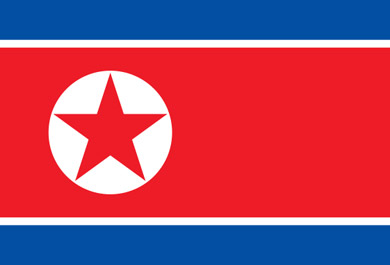
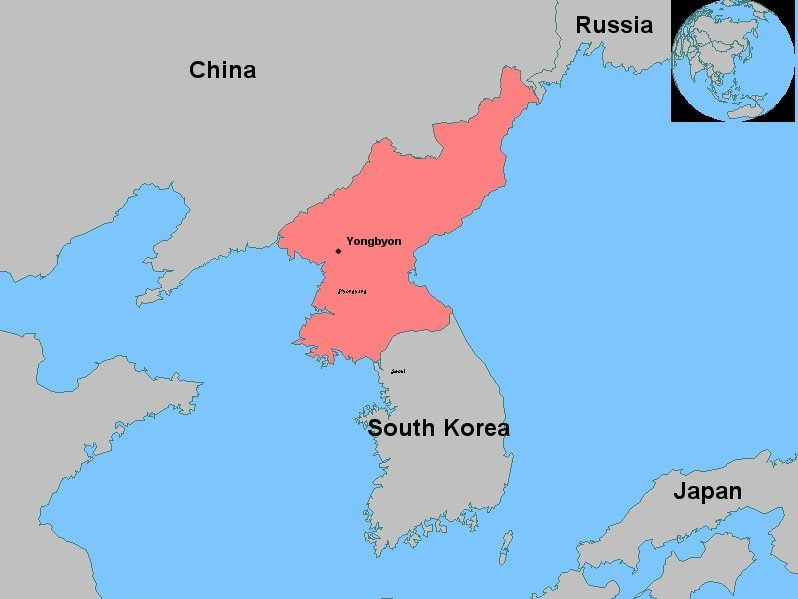 NORTH KOREA
NORTH KOREA
May 2014
With fewer than 1,000 British tourists each year visiting North Korea or the Democratic People's Republic of Korea (DPRK), this country was truly one of the last remaining unknown and mysterious places in the world. One American described North Korea as a country only a mother could love. Entry requirements have been relaxed to facilitate the ease of travel although still strictly controlled in comparison with all other tourist destinations. It was understood that visits to the DPKR are strictly on government terms with limited independence and unlimited flexibility by visitors is required and each tour is accompanied by two tour guides at all times (in case one is tempted by western decadence) and an official photographer.
The DPKR, with a population of 23 million of which 3 million live in the capital, continues to be a very closed society where those living outside Pyongyang need a special permit to visit the capital and those living in the capital need a permit to visit the country. There was no internet or email service and foreigners were not permitted to bring mobile and smart phones into the country, they would be confiscated on entry and returned on departure. This presented an interesting dichotomy for me as I normally take my BlackBerry on holiday to keep an eye on the 150 or so emails I get each day. I returned to an inbox of over 1,000 emails but fortunately no disasters or calamities had befallen my colleagues whilst I was away.
The DPKR demands complete respect and reverence for its past and present leaders from all of its citizens and visitors with severe penalties for any contravention. Making George W Bush type jokes about their leaders is just not possible albeit there could be many jokes about the pantomimical current leader's (Kim Jong-un) ridiculous hair style. Former leader, Kim il Sung is known as the eternal president who was in power for 48 years after World War II until his death in July 1994 and absolute veneration for him was expected without question.
The only way for tourists to arrive in the DPKR is via its only friend in the world, China. Having flown via Beijing, we landed in the capital Pyongyang, where we were introduced to our guides, two young girls Honey and Song, looking barely old enough to be out of school but in fact in their mid-twenties with astonishingly perfect English considering the isolation of their country and the limited access to foreigners.
Upon arrival in the capital we were treated to a tour of the city's highlights including the Geumsusan Memorial Palace, the Triumphal Arch, the Daedong River and Kim iL-sung Square which was clearly modelled on similar vast expanses in the former Soviet Union such as Red Square. The hotel that we subsequently checked into was surprisingly comfortable being the approximate equivalent of a British 4-star establishment. Whilst the rest of the group decided to have an early night at 21:00(!), I decided to visit the hotel bar, where I was rewarded by being joined by our two tour guides Honey and Song. Not only did they have an impressive capacity for alcoholic consumption, their understanding and usage of the English language, including idioms such as "let's hit the sack", was outstanding. Honey was single and seemed to be taking a keen interest in me although I was naturally sceptical of her motives. However we established a good rapport and she made a point of sitting next to me on the coach whenever possible.
We took a trip to Mount Myohyang which was named after the mystic shapes and fragrances found in the area. It is a sacred site as, according to legend, it was the home of King Tangun, forefather of the Korean people. The area incorporates the Pohyon temple, built in the 11th century and we also visited the International Friendship Exhibition centre, dubbed the world's biggest treasure-house. On exhibit were gifts received by North Korean leaders over the years from foreign visitors, politicians and dignitaries. One building stores the presents given to Kim Il-Sung, while a smaller one holds those given to his son Kim Jong-iL.
Driving around North Korea on clearly carefully choreographed routes we nonetheless were able to absorb some telling observations about the reality of living in this secretive state. It is obviously a very controlled society with an ordered and well-mannered life. The streets were spotlessly clean and young children were free to roam the streets unaccompanied after dark in perfect safety. However a similar luxury was not extended to foreigners who were not permitted to be outside the hotel without their tour guide - estimated survival time before arrest a few seconds! North Korean people are very well tailored, with women in pretty dresses and men in regulation black suits, white shirts and ties. There are 18 state approved hairstyles for women and 10 for men! Not sure whether you are permitted to dye your hair in the DPRK.
Recently the North Koreans have been issuing bellicose and aggressive statements against the South Koreans and the Americans, threating to launch missiles and other military strikes. Well, judging by the state of their ramshackle army vehicles that we discerned, often broken down, with soldiers asleep at the roadside, these pronouncements were axiomatically just vacuous jingoisms. Another striking feature was the number of people working in the paddy fields producing the omnipresent staple dish of rice which accompanied just about every meal we had. Still I guess rice (which I don't particularly like) is better than eating grass as it was rumoured that North Koreans were forced to resort to recently.
Feeling impotent without my BlackBerry to hand, my thoughts wandered to the office and whether there was anything for me be concerned about. I somehow managed to also discover (I think from BBC World News in our hotel) that Leyton Orient's amazing start to the new football season where they won the first eight games continued in my absence.
Our next trip was to spend more time visiting the sites of Pyongyang which we had fleetingly visited on our whistle-stop tour when we first arrived. We visited Kumsusan Palace of the Sun, Grand Peoples Study House, Kim iL Sung Square, Mansudae Fountain Park, Mansudae Grand Monument and the Juche Tower. Impressive! We also watched goose-stepping North Korean soldiers undertaking their drill and practice. Following lunch on a boat (more rice of course!) it was a busman's holiday for me as we plunged to the centre of the earth to ride the Pyongyang metro, which is the deepest in the world at 110 metres, with stations called Renunification, Victory and Battle. Some stations were marble-clad, illuminated by crystal chandeliers rather like the Moscow and St Petersburg equivalents. This was an opportunity to sit next to real Korean people and despite my best efforts to cement Anglo - Korean cordials with stimulating dialogue, my Korean linguistic skills were non-existent and other than the tour guides, no-one spoke any English. We rounded off a fascinating day with a visit to the Arch of Triumph which was built to commemorate the Korean resistance to Japan from 1925 to 1945. It is the second tallest triumphal arch in the world (after Monumento a la Revolucion in Mexico), standing 197 feet high and 164 feet wide.
That night we went to an amazing acrobatic show featuring highly-skilled young performers undertaking death-defying stunts,aerial tricks and heart-stopping manoeuvres. These North Koreans practice very hard to hone their skills and their talent and genius was a pleasure to enjoy.
The following day we were taken to the Demilitarized Zone (DMZ) in Panmunjon - the border between South and North Korea. Quite why it is tagged as demilitarized when it is the most heavily militarized area in the world is a conundrum! On the journey to the DMZ, for the only time on the trip we were subjected to North Korean propaganda from the tour guides and I thought the points that they were trying to get across were reasonable although no-one else on the trip agreed with me. Their viewpoint was that if the USA has nuclear weapons, why shouldn't the DPRK? Who is the only country in the world ever to have unleashed a nuclear bomb? I'd been to Panmunjon before but from the South Korean side so it was fascinating to see it from an alternative standpoint and the different ways in which the issues facing the two Korean powers were presented.
On the return journey we stopped off at the Koryo History Museum which represented a Confucian educational facility of the Koryo dynasty now a museum displaying historical remains and relics showing the foundation and development of the dynasty. Next we visited the Tomb of King Kongmin, a 14th-century mausoleum being one of the Royal Tombs of the dynasty. The site consists of two separate burial mounds, containing the remains of Kongmin, and his wife, the Mongolian princess Queen Noguk. Nominated for World Heritage status, it is one of the best preserved royal tombs in North Korea which remains in its original state, having avoided extensive "restoration" under the Communist government. Our final stop on a long and tiring day of sightseeing was at a "model" North Korean farm, meeting a happy smiling family extolling the virtues of living and working in the DPRK.
Tony and I were particularly struck with the ubiquitous feminine traffic wardens that are on pretty much every street corner. This is a highly prestigious role in North Korean society, and unlike in the UK and elsewhere, only elite and well-educated candidates are offered the positions. Their role is to ensure smooth traffic management which is hardly much of a problem in Pyongyang. Along with a North Korean football shirt, I managed to buy a souvenir traffic warden "doll" which now sits proudly in my house!
The next leg of our tour was a trip to the coastal town of Wonsan and a visit to the Ullim waterfall. Hardly Niagara or Victoria, but picturesque nonetheless. We continued on the tranquil and deserted Sijung beach for a taste of North Korean seaside charms. We moved rapidly on to the Mount Kumgang (diamond mountain) tourist region. The 200 square mile area with a high point of 1,638 metres, was established in 2002 to handle the one million South Korean tourists who, since 1998 have been allowed to visit, travelling at first by cruise ship, but more recently by bus on a newly built road through the DMZ.
We stayed at the, again, surprisingly luxurious Oi-Kumgang hotel for 2 nights. I took my LOFC shirt with me on this trip and decided to visit the hotel shop wearing it. This caused much consternation amongst the hotel workers who kept pointing at my shirt and waving their arms. Momentarily dumbstruck, surely they've not heard of such a small and underperforming team from the third tier of the football hierarchy in the UK? Then I got it .... LOFC were sponsored by South Korean Samsung with their emblem emblazoned across my shirt .... how insensitive was that!
The group gathered in the hotel bar for an extended late night drinking session which appeared to freak the hotel staff who seemed unprepared for the tsunami of drink orders with little or no access to any change for our Euro bills (US dollars not accepted!). This lead to chaotic scenes of who owed what to whom and bar staff were approaching tourists asking for Euro payments for drinks consumed two days earlier! Mike seemed to be making romantic overtures to one of the young North Korean barmaids and I observed a level of reciprocity although being the true gentleman that he was, no details were revealed despite much probing from Tony and me!
Despite the late night and associated alcoholic excesses the whole group promptly gathered for a day of strenuous trekking and hiking across rough terrain to visit the scenic valley of Kuryong and the inevitable waterfall. This was followed by a visit to the pictorial Samil Lagoon where some of the group adventured for an impromptu swim that I watched from the adjacent sandbank. On the way back to Pyongyang, we stopped off at the spectacular Tomb of King Tongmyon which is a mausoleum containing 63 individual tombs of which fifteen are believed to belong to various vassal lords (a person under the protection of a feudal lord). The Tombs achieved UNESCO World Heritage status in 2004 and contained a rich collection of mural paintings, frescoes, a Buddhist monastery, the Chongrŭngsa Buddhist temple and stone figurines of soldiers, horses and lions.
That evening the group enjoyed a sumptuous farewell dinner at the upscale Pyongyang Duck restaurant and on the coach back to the hotel I had the privilege of representing the group with a thank you speech for our guides, drivers, photographer etc.
We returned to China with an overnight stay at a top Beijing hotel which was eye-wateringly expensive, especially compared to what we had been used to in the DPRK! A great trip, engaging group and although we clearly only saw what the North Koreans wanted us to see nonetheless they can't control everything and we got an impression of what life was like in the world's most secretive state.
Last updated: 27th April 2016
Click photo for full size image
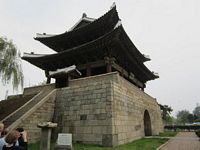
Let's pray
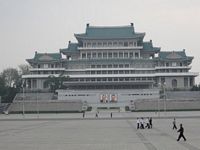
Ubiquitous leaders
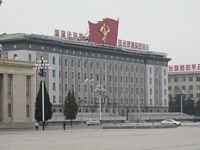
Communism prevails
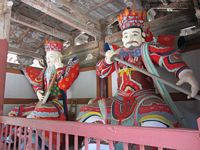
Lifesize toys
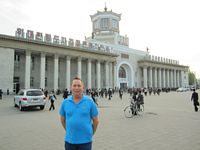
Minder-less
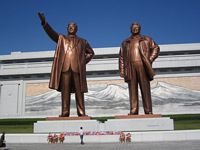
The Great Leaders
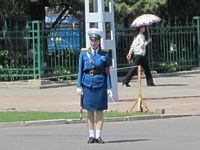
Elite position
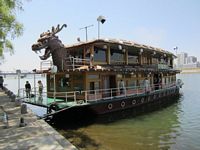
Beats the Woolwich ferry
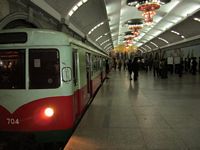
Spotlessly "Sovietesque"
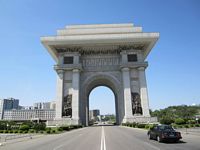
Pyongyang or Paris?
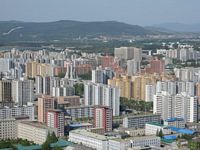
Pyongyang sink estate
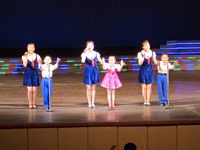
Perfect performers
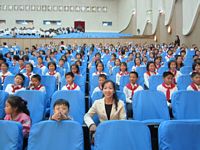
TJ fan club
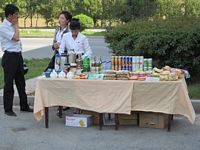
Costa Coffee DPR-K style
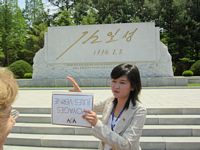
If only "Honey" lived in Woodford Bridge
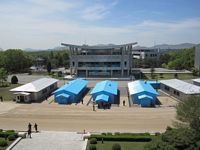
Who's watching who?
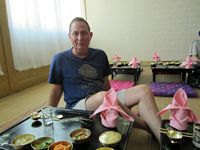
When in Rome